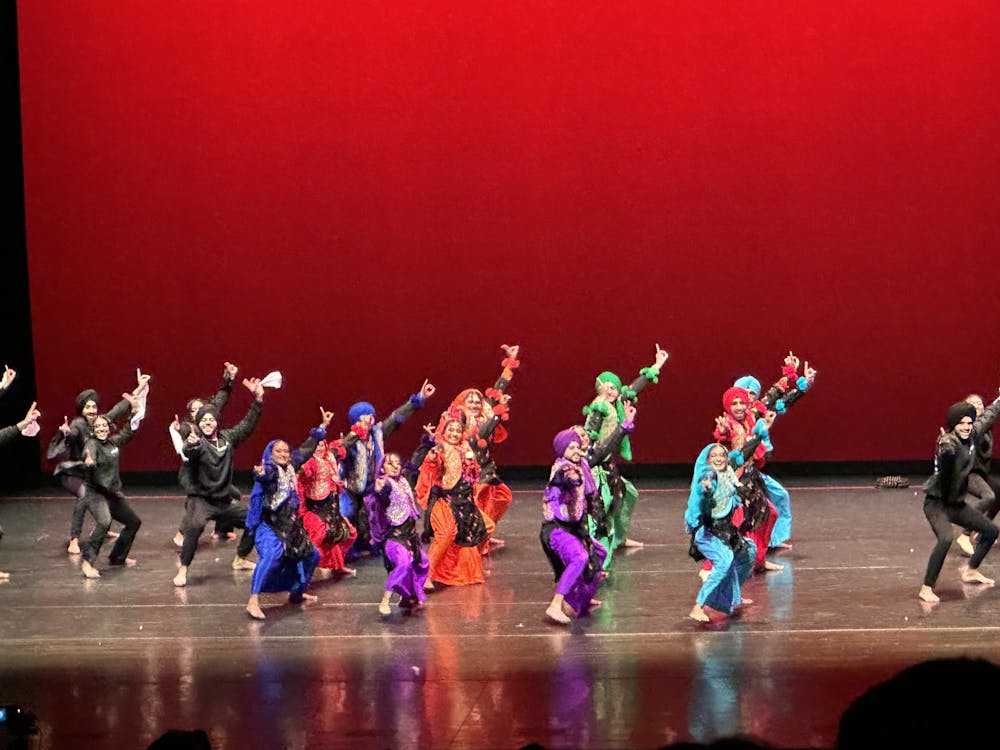Vibrant colors adorned the Center for the Arts (CFA) mainstage at this year’s International Fiesta.
But where do these colorful garments come from, and what do they mean?
In keeping with the theme of harmony, the Sri Lankan Student Association (SLSA) chose to represent the reconciliation between the Northern Tamil-speaking region and Southern Sinhalese-speaking region by coordinating the color of their garments with the maroon, yellow and orange in their country’s flag. The group had to order their traditional garments custom-made from Sri Lanka, which meant allotting one month ahead of the performance for its arrival.
Chaitra Telukala, an SLSA member and sophomore majoring in information technology, portrays a Sinhalese girl in the performance. She wore a maroon square-neck blouse with gold embroidery with bottoms that were draped dhoti-style — the same manner in which sarees are draped — and secured by a belt. Putting together such an ensemble meant Telukala and her team had to start getting ready at 7 a.m. Each person’s draping took two hours.
“I think like three people did my makeup. One person did my hair. Two people did my draping and the belt, securing it [took] two others,” Telukala said.
Telukala was adorned in jewelry like the choti, a long golden white ornament which protrudes from the top of the scalp and has a circular centerpiece dangling in front of her forehead and bangles.
Headwear was also a significant feature for members of the Organization of Arab Students (OAS), whose heads were wrapped with the keffiyeh, a headdress with colors and patterns that signify the longstanding resistance against oppression. While color patterns vary throughout the Middle East, keffiyehs tend to be red and white in areas close to the Gulf Coast like Saudi Arabia and Yemen, and black and white in places like Palestine and Jordan.
According to Sarah Hamdan, a senior public health major and law minor, the fishnet patterns on the keffiyeh indicate regions that are close to the sea, like Palestine, Lebanon and Jordan. Some keffiyehs have olive branch leaves detailed across to represent peace.
Hamdan’s father, who grew up during the Lebanese Civil War, would wear the keffiyeh to school with his brothers all the time.
“It’s kind of like a 360 now coming to school here in America and wearing my keffiyeh with my friends,” Hamdan said.
Hamdan says they were still “underdressed” since the full ensemble normally includes a vest, boots and the tarboosh, a red hat with a tassel that men usually wear. But the entire group also sported a black top and parachute pants, with an oversized fit to emphasize the jumping in the dabke choreography. A gold belt with coins dangles around their waist to accompany the movement of their hips in their belly dancing with sound.
The Filipino Student American Association’s (FASA) performance told the story of the divide between the Philippines’ poor slums and rich gated communities. The male students portraying wealth wore barongs, an off-white embroidered blouse typically made from banana and pineapple fibers, while the female students wore filipinianas, a traditional dress with the top half resembling a barong and the bottom half consisting of a beige maxi skirt.
The poor characters wore tattered beige shirts with black tattoos along their arms, which are markings that unify the community, according to Kyle Chacon, FASA’s cultural chair and a sophomore intended nursing major.
For students representing their cultures through music and dance this past weekend, clothing proved to be an equally important element of the performances.
Tenzin Wodhean is a senior arts editor and can be reached at tenzin.wodhean@ubspectrum.com





